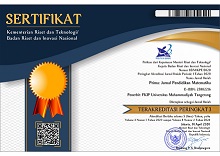DEVELOPMENT OF MATHEMATICS INTERACTIVE MULTIMEDIA WITH SCRATCH TO ENHANCE STUDENT'S MATHEMATICS UNDERSTANDING ABILITY
Abstract
Interactive media is something that is important to be developed in order to improve students' mathematical understanding abilities. One of the learning media used is scratch. Scratch-assisted learning media on rank numbers material is made to make it easier for students to understand concepts and to increase student interest in learning, by studying it is expected to be able to give birth to creative students in making learning media based on scratch animation. The research design used in this research is the research design of 4D model development (Four D Models). This includes 4 stages, namely the definition, design, development and dissemination stages, which the researcher then simplifies by changing from four stages (4D) to three stages (3D), namely: defining, designing and developing.
Keywords
Full Text:
PDFReferences
Afgani, Jarnawi. (2011). Materi Pokok Analisis Kurikulum Matematika, Jakarta: Universitas Terbuka
Alan, U. F & Afriansyah, E. A. (2017). Kemampuan Pemahaman Matematis Siswa Melalui Model Pembelajaran Auditory Intellectualy Repetition dan Problem Based Learning. Jurnal Pendidikan Matematika. 11 (1). DOI: http://dx.doi.org/10.22342/jpm.11.1.3890.67-78
Balanskat, Anja & Engelhardt, Katja. (2014). Computing our Future. 10.13140/RG.2.1.5029.9048.
Benton, L., Hoyles, C., Kalas, I., & Noss, R. (2017). Bridging primary programming and mathematics: Some findings of design research in England. Digital Experiences in Mathematics Education, 3(2), 115–138. doi:10.1007/s40751-017- 0028-x
Brennan, K., Balch, C., & Chung, M. (2014). Creative computing. Retrieved from http://scratched.gse.harvard.edu/guide/
Calao, L. A., Moreno-León, J., Correa, H. E., & Robles, G. (2015). Developing Mathematical Thinking with Scratch. In G. Conole, T. Klobučar, C. Rensing, J. Konert, & É. Lavoué (Eds.), Design for Teaching and Learning in a Networked World: 10th European Conference on Technology Enhanced Learning, EC-TEL 2015, Toledo, Spain, September 15–18, 2015, Proceedings (pp. 17–27). Cham: Springer International Publishing.
Cynthia Solomon, Brian Harvey, Ken Kahn, Henry Lieberman, Mark L. Miller, Margaret Minsky, Artemis Papert, and Brian Silverman. (2020). History of Logo. Proc. ACM Program. Lang. 4, HOPL, Article 79 (June 2020), 66 pages. https://doi.org/10.1145/3386329
Dohn, Niels Bonderup. (2019). Students’ interest in Scratch coding in lower secondary mathematics. British Journal of Educational Technology. Vol.0, No.0, 2019, 1–13, doi:10.1111/bjet.12759
E. C. Förster, K. -T. Förster and T. Löwe, "Teaching programming skills in primary school mathematics classes: An evaluation using game programming," 2018 IEEE Global Engineering Education Conference (EDUCON), 2018, pp. 1504-1513, DOI: 10.1109/EDUCON.2018.8363411.
Ford, J. L. (2009). Scratch Programming for Teens. Boston: Course Technology.
Hughes, J., Gadanidis, G., & Yiu, C. (2017). Digital making in elementary mathematics education. Digital Experiences in Mathematics Education, 3(2), 139–153. doi:10.1007/s40751-016-0020-x
José Antonio Rodríguez - Martínez, José Antonio González - Calero
& José Manuel Sáez - López (2019): Computational thinking and mathematics using Scratch: an experiment with sixth-grade students, Interactive Learning Environments, DOI: 10.1080/10494820.2019.1612448
Kindergarten, L. (2013). Scratch. Retrieved September 14, 2017, from MIT:https://resources.scratch.mit.edu/www/guides/en/Getting-Started-Guide-Scratch2.pdf
Lestari, K. E & dan Yudhanegara, M. R. (2017). Penelitian Pendidikan Matematika. Bandung: PT. Refika Aditama.
Maloney, J. H., Peppler, K., Kafai, Y., Resnick, M., & Rusk, N. (2008). Programming by choice. In Proceedings of the 39th SIGCSE technical symposium on computer science education - SIGCSE ‘08 (Vol. 40, pp. 367–371). New York: ACM Press. doi:10.1145/1352135.1352260
N. Zamin, H. Ab Rahim, K. S. Savita, E. Bhattacharyya, M. Zaffar and S. N. Katijah Mohd Jamil, "Learning Block Programming using Scratch among School Children in Malaysia and Australia: An Exploratory Study," 2018 4th International Conference on Computer and Information Sciences (ICCOINS), 2018, pp. 1-6, DOI: 10.1109/ICCOINS.2018.8510586.
Papert, S.A. (1990). A critique of technocentrism in thinking about the school of the future. Cambridge, MA: Epistemology and Learning Group, MIT Media Laboratory.
Price, T. W., & Barnes, T. (2015, July). Comparing textual and block interfaces in a novice programming environment. Proceedings of the 11th annual international conference on international computing education research (pp. 91–99). Nevada, US: ACM.
Resnick, M., Silverman, B., Kafai, Y., Maloney, J., Monroy-Hernández, A., Rusk, N., ... Silver, J. (2009). Scratch: Programming for all. Communications of the ACM, 52(11), 60–67. doi:10.1145/1592761.1592779
Su, A. Y. S., Yang, S. J. H., Hwang, W.-Y., Huang, C. S. J., & Tern, M.-Y. (2014). Investigating the role of computer-supported annotation in problem-solving-based teaching: An empirical study of a Scratch programming pedagogy. British Journal of Educational Technology, 45(4), 647–665. https://doi. org/10.1111/bjet.12058
Utting, S. Cooper, M. Ko ̈lling, J. Maloney, and M. Resnick. (2010). “Alice, green food, and scratch - A discussion,” TOCE, vol. 10, no. 4, pp. 17:1–17:11. http://doi.acm.org/10.1145/ 1868358.1868364
Taylor, M.; Harlow, A.; Forret, M. Using a computer programming environment and an interactive whiteboard to investigate some mathematical thinking. Procedia-Soc. Behav. Sci. 2010, 8, 561–570.
Wing, J. M. (2008). Computational thinking and thinking about computing. Philosophical Transactions Mathematical Physical and Engineering Sciences, 366(1881), 3717–3725. https://doi.org/10.1109/ipdps.2008.4536091.
Wong, G. K., Cheung, H. Y., Chang, E. C., & Huen, J. M. (2015, December). School perceptions of coding education in K-12: A large scale quantitative study to inform innovative practices. 2015 IEEE International Conference on Teaching, Assessment, and Learning for Engineering (TALE) (pp. 5–10). Zhuhai, China: IEEE.
DOI: http://dx.doi.org/10.31000/prima.v7i1.7437
Article Metrics
Abstract - 2240 PDF - 1640Refbacks
- There are currently no refbacks.
Prima: Jurnal Pendidikan Matematika
Program Studi Pendidikan Matematika
Fakultas Keguruan dan Ilmu Pendidikan
Universitas Muhammadiyah Tangerang
Jl. Perintis Kemerdekaan I/33, Cikokol
Kota Tangerang, Indonesia
e-mail: primajpm@gmail.com
Prima: Jurnal Pendidikan Matematika (p-ISSN: 2579-9827 | e-ISSN: 2580-2216) is licensed under a Creative Commons Attribution 4.0 International License.







